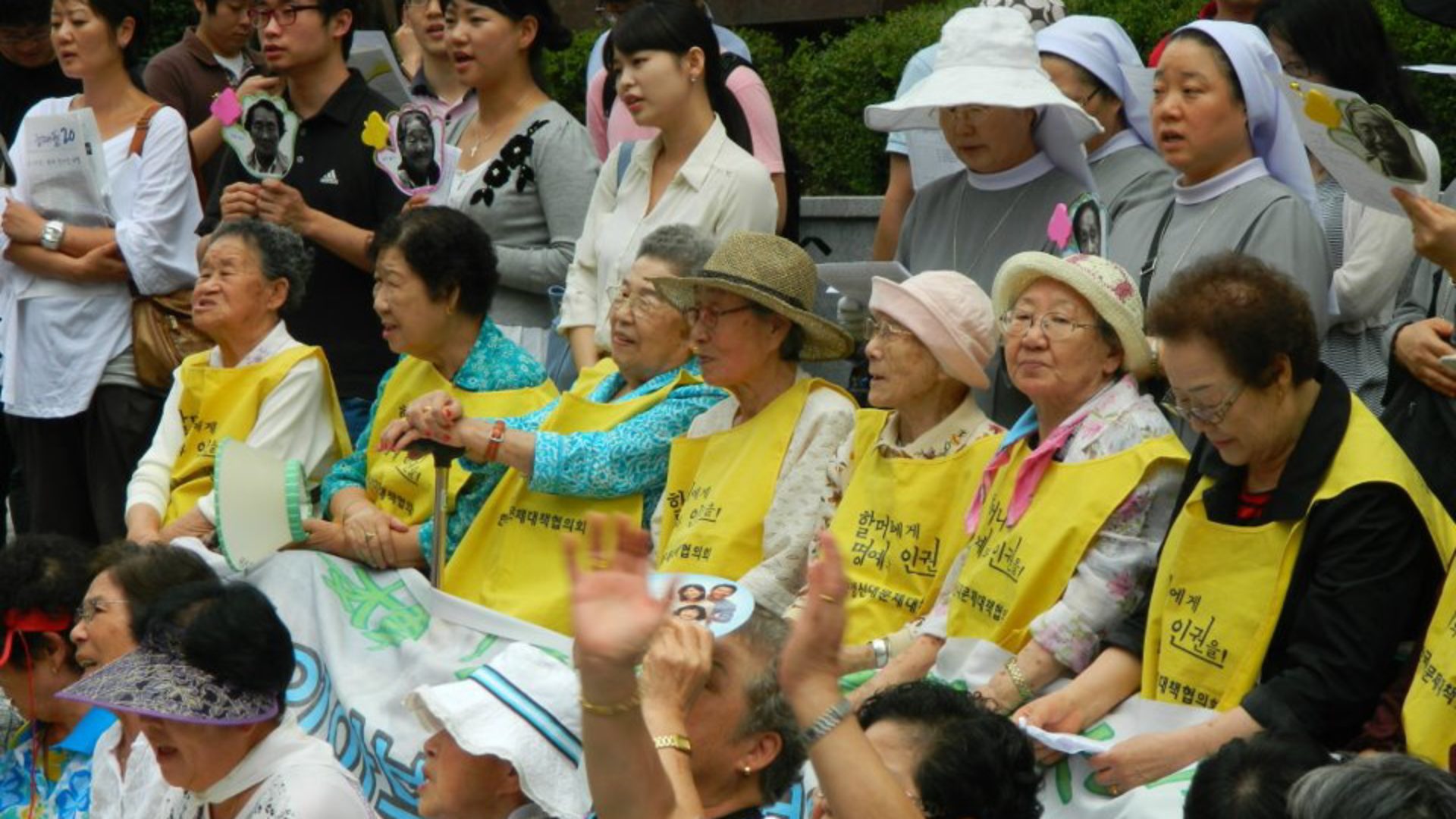Click HERE to download a PPT about the ‘Comfort Women’ movement in the United States.
“Comfort Women” is a euphemistic term, referring to the hundreds of thousands of women enslaved to provide sex for the Japanese Imperial Armed Forces during 1930s and WWII. Known to be the largest case of the institutionalized sexual slavery and human trafficking in the 20th Century, young women and minor children as young as 11 years old from Japan’s colonies (Korea and Taiwan) and occupied territories (China, Burma, Indonesia, Malaysia, The Philippines, Vietnam, Thailand, India, East Timor and more) were forcibly recruited, tricked or abducted and trafficked to the hundreds of rape camps – “comfort stations” – where they suffered from incarceration, gang rape, torture, forced abortion, cruel physical and psychological abuses that led to numerous suicide. The Japanese military was systematically involved in the creation, maintenance and operation of the “comfort station” that were located throughout the Asia Pacific, however, the Japanese government has never been held accountable for this crime against humanity.

In the United States
When survivor Hak-soon Kim first broke the silence publicly in 1991, the world responded and the UN declared rape during war is a crime against humanity. Since early 1990s, American citizens and politicians made efforts to raise awareness about the Japanese military sexual slavery during WWII by bringing the surviving victims to the US for speech tours. However, the public was largely unaware of this history until there was a nationwide grassroots campaign in 2007, to pass the House Resolution 121 at the United States House of Representatives that urged the Japanese government to acknowledge and accept the historical responsibility for the so-called “Comfort Women” atrocity. 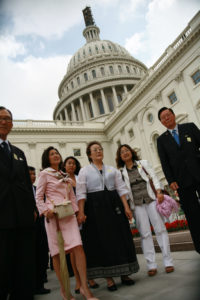
The Japanese government fought hard. Under the history revisionist Shinzo Abe as the Prime Minister, the far-right wing Japanese politicians and citizens lobbied the US Congressmen to not support the Resolution, took out a full page AD on a major newspaper to deny the “Comfort Women” history, and rallied the local Japanese community to oppose the resolution. The Japanese government played underhand to sabotage the memorial projects by the American citizens and local governments to remember and honor the victims of the Japanese military sexual slavery. However, memorial movement spread like wildfire throughout the United States, starting with Palisades Park, New Jersey in 2010 and then later in Glendale, CA, Brookhaven, GA, San Francisco, CA and other places.
The history revisionists even brought a federal lawsuit against the City of Glendale, the first US city to install the Peace Monument (Korean girl sitting in a chair next to an empty chair). The plaintiffs sought removal of the Peace Monument from Glendale Central Park.
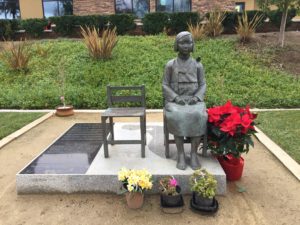
When the words about the lawsuit got out, the law firm for the plaintiffs was heavily criticized for representing the history revisionists in the legal community that it withdrew from the lawsuit after two months. The lawsuit was dismissed at the lower court, but the plaintiffs appealed twice, all the way up to the US Supreme Court. In March 2017, the US Supreme Court refused to review the case, finalizing the original decision by the lower court that dismissed the case. The plaintiffs filed another lawsuit against the City of Glendale in the California State Court, but the plaintiffs lost the anti-SLAPP motion and were ordered to pay $300,000 legal fees to the City of Glendale.
 When an American textbook publisher McGraw-Hill included a small section about the “Comfort Women” in its world history book, the Japanese government diplomats demanded deletion or revision of the content, saying that the women were not sex slaves. This incident was widely reported in the major news media such as New York Times and The Wall Street Journal in late 2014. A group of scholars (led by Professor Alexis Dudden of University of Connecticut) of Japan studies and East Asian history issued a letter denouncing the Japanese government’s revisionist position and its attempt to skew history. This letter garnered about 500 signatures around the globe by May 2015. The Japanese government set up $500 Million annual budget to wage a “History War” in the United States since 2015 and it continues to dispute in the international community that the “Comfort Women” were not sex slaves.
When an American textbook publisher McGraw-Hill included a small section about the “Comfort Women” in its world history book, the Japanese government diplomats demanded deletion or revision of the content, saying that the women were not sex slaves. This incident was widely reported in the major news media such as New York Times and The Wall Street Journal in late 2014. A group of scholars (led by Professor Alexis Dudden of University of Connecticut) of Japan studies and East Asian history issued a letter denouncing the Japanese government’s revisionist position and its attempt to skew history. This letter garnered about 500 signatures around the globe by May 2015. The Japanese government set up $500 Million annual budget to wage a “History War” in the United States since 2015 and it continues to dispute in the international community that the “Comfort Women” were not sex slaves.
At the end of 2015, the Japanese government and the South Korean government struck a backdoor deal and announced the issue was now “finally and irreversibly” resolved at a joint press conference held by the foreign ministers of the two countries.
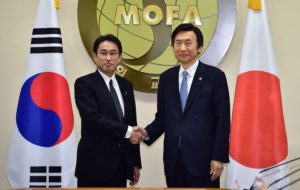
A renowned professor and the director of Asian Studies at Temple University in Tokyo, Jeff Kingston sums it up: The agreement to solve the comfort women issue “finally and irreversibly” was dead on arrival because it did not meet 21st century expectations and norms about a victim-centered process. The former comfort women were not consulted during secret negotiations and Abe never made a public apology, only calling it in to Park. This lack of empathy meant that Japan’s agreement to pay 1 billion yen ($9.8 million) to support the aging victims never gained traction, especially because Tokyo expected that in return South Korea would remove the comfort women statue across the street from the Japanese Embassy in Seoul and adhere to a gag order on raising the issue internationally (https://thediplomat.com/2018/08/little-to-celebrate-on-20th-anniversary-of-obuchi-kim-declaration/). Nonetheless, this so-called Agreement caused a great deal of confusion and misconception among the major media and the US government officials as if the issue was indeed “resolved” and the victims were to be satisfied with the 1 billion-yen payment by the Japanese government.
However, the two UN Human Rights reports by human rights experts Coomaraswamy and McDougal, as well as various UN bodies such as Committee on the Elimination of All Discrimination Against Women (CEDAW) in 2016 and the Committee on the Elimination of Racial Discrimination (CERD) in 2018 concluded the “Comfort Women” victims were sex slaves and urged the Japanese government over and over again to take a victim-centered approach to resolve this issue. It took persistent efforts on the part of the grassroots movement in the US, including inviting the surviving Grandma to hold press events and to meet with American politicians and community leaders, to finally reverse the misconception about the deal that actually did more harm than good for the victims’ cause.
In 2016, with strong support from the California residents, the State of California’s Department of Education adopted a curriculum for the 10th Grade World History that includes a description about the “Comfort Women,” despite strong oppositions and lobbying by the Japanese government against it.
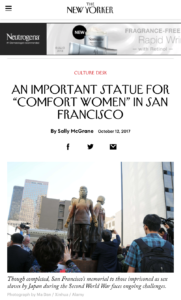 In 2017, San Francisco became the first major US city to install its own memorial dedicated to the “Comfort Women” that features three young girls (Korean, Chinese and a Filipino) holding hands and a grandma looking at them. The unveiling ceremony drew major international media attention. See New Yorker article about it. However, when the Mayor of Osaka, the Japanese sister city of San Francisco, announced that it will sever the sister city relationship over the acceptance of the “Comfort Women” memorial as the city property(see New York Times article), the international media attention exploded and actually it helped more people to understand the dark history of Japan’s war crime during WWII and the ongoing denial and history revisionism. Now the “Comfort Women” memorial in St. Mary’s Square is the newest landmark in San Francisco where dozens of people visit every day to see and learn about the history of the “Comfort Women” and the need to eradicate sexual violence against women during military conflict.
In 2017, San Francisco became the first major US city to install its own memorial dedicated to the “Comfort Women” that features three young girls (Korean, Chinese and a Filipino) holding hands and a grandma looking at them. The unveiling ceremony drew major international media attention. See New Yorker article about it. However, when the Mayor of Osaka, the Japanese sister city of San Francisco, announced that it will sever the sister city relationship over the acceptance of the “Comfort Women” memorial as the city property(see New York Times article), the international media attention exploded and actually it helped more people to understand the dark history of Japan’s war crime during WWII and the ongoing denial and history revisionism. Now the “Comfort Women” memorial in St. Mary’s Square is the newest landmark in San Francisco where dozens of people visit every day to see and learn about the history of the “Comfort Women” and the need to eradicate sexual violence against women during military conflict.
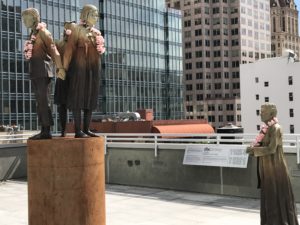
In early 2018, Shinsuke Sugiyama, the new incoming Japanese Ambassador to the United States announced that he will do everything he can to remove all the “Comfort Women” memorials in the United States. With the annual budget of $500 Million to whitewash and downplay its war crimes, Japanese government cannot be further away from squarely accepting its historical responsibility. However, the power of truth has always prevailed and the people in the United States are working hard to preserve and teach the historical truth, so that the egregious, systematic crime of sexual slavery of women by a government never recurs.
